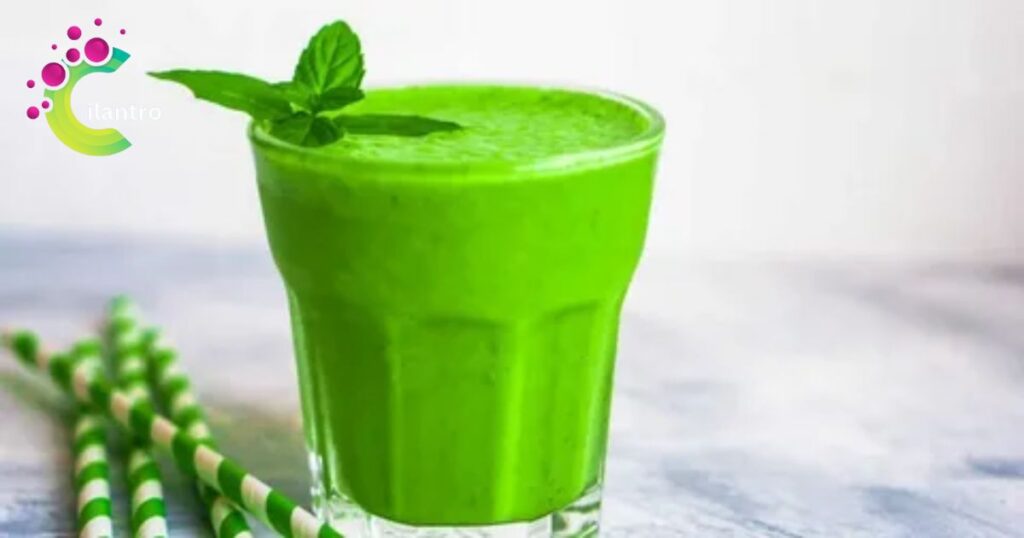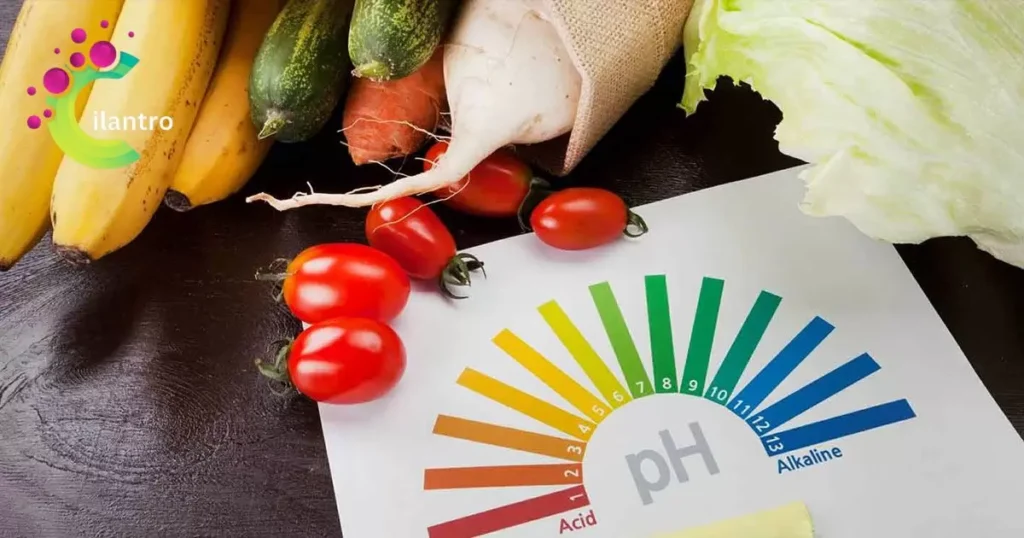Cilantro is neither highly acidic nor alkaline; its pH is close to neutral. In culinary contexts, it is often considered a fresh and herbaceous ingredient, enhancing dishes with its unique flavor profile.
We delve into the scientific aspects of this herb, specifically focusing on whether it is acidic or alkaline. By examining its nutritional composition, pH levels, and culinary applications, we aim to uncover the mysteries surrounding cilantro, and the question is here, Is cilantro acidic or alkaline? Cilantro is not merely an herb; it holds cultural significance in diverse culinary traditions.
Cilantro, also known as coriander leaves, is a versatile herb widely used in culinary traditions worldwide. Its distinctive flavor and aroma make it a popular ingredient in various cuisines. Discuss cilantro’s roots, tracing its usage back to ancient civilizations like the Egyptians, Greeks, and Romans.
In this article, we examine historical texts and artifacts that mention cilantro, showcasing its enduring presence, so stay tuned with us!
The Science Behind Cilantro’s Taste
Cilantro’s taste is a unique experience for each person. Some love it, while others find it soapy. Scientists say genetics play a role. A specific gene detects aldehyde chemicals in cilantro, making it taste fresh or like soap. If you’re a fan of cilantro and want to enhance your culinary experience, consider trying it in various dishes, perhaps in a delicious Cilantro Pepita Dressing.
Cultural influences also shape our cilantro preferences. Exploring the science behind cilantro’s taste adds flavor to understanding our diverse palates.
Nutritional Composition of Cilantro

Cilantro Acidic is more than a tasty herb; it’s packed with nutrients. Rich in vitamins and minerals, cilantro promotes overall health. Including it in your diet supports immune function and helps maintain strong bones. So, enjoy Cilantro Acidic not just for its flavor but also for the nutritional boost it provides!
Nutrient Content
It is a nutritional powerhouse, packed with vitamins (A, C, K), minerals (Iron, potassium), and antioxidants. These elements contribute to its potential health benefits, including improved digestion and immune support.
Health Benefits
The antioxidants in cilantro, including its vitamin K content crucial for bone health, may help combat oxidative stress. Understanding the nutritional value adds depth to the appreciation of this herb’s unique qualities, such as its distinct taste profile, often described as refreshing and slightly citrusy hence the term cilantro acidic.
Is cilantro good for your stomach?

Cilantro is good for your stomach. It helps with digestion. The leaves contain antioxidants. These can soothe inflammation. Cilantro may ease stomach discomfort. Including it in your diet is beneficial.
It is also known as coriander leaves and offers various advantages for your stomach health. It is rich in antioxidants, such as quercetin and tocopherols, which can help reduce inflammation in the stomach lining.
This herb has natural antibacterial properties that may assist in combating harmful bacteria in the digestive system, promoting a healthier gut.
Additionally, Cilantro Acidic contains compounds that can stimulate the production of digestive enzymes, aiding in the breakdown of food and easing the digestive process.
Including cilantro in your meals may also alleviate symptoms of indigestion and bloating. Its soothing properties make cilantro a flavorful and beneficial addition to your diet for maintaining good stomach health.
Cilantro Acidic pH Scale and Acidity/Alkalinity

Cilantro has a slightly acidic nature, with a pH falling in the range of 6 to 7. This means it is mildly acidic on the pH scale.
The acidity of cilantro is subtle, contributing to its distinctive flavor profile. While not as tangy as citrus fruits, cilantro adds a pleasant and refreshing zing to dishes.
Understanding its acidic nature, such as cilantro acidic, is essential for balancing flavors in recipes, especially when combined with other ingredients.
Overall, cilantro’s mild acidity enhances the taste of various culinary creations.
pH Scale Explanation
The pH scale measures how acidic or alkaline a substance is. It ranges from 0 to 14, with 7 being neutral. Substances with a pH less than 7 are acidic, while those with a pH greater than 7 are alkaline.
Lemon juice and vinegar are examples of acidic substances. Baking soda and soap are examples of alkaline substances.
Understanding pH helps us control the acidity, oralkalinity, and pH of various solutions in our daily lives.
Cilantro’s Role in Traditional Medicine

Cilantro, a vibrant herb, has a vital role in traditional medicine worldwide. People use cilantro for its potential health benefits. Its leaves are rich in antioxidants, believed to promote overall well-being.
In various cultures, cilantro is used to alleviate digestive issues, such as bloating and indigestion. Some also embrace its potential to support detoxification.
As a versatile herb, cilantro continues to play a significant role in traditional healing practices, adding flavor to dishes while contributing to holistic health.
Medicinal Uses
Examine the traditional medicinal uses of cilantro, such as its purported anti-inflammatory and detoxifying properties. Connect these uses to its nutritional composition and pH.
pH and Therapeutic Properties
Investigate whether cilantro’s pH level contributes to its therapeutic properties. This section adds depth to the discussion about cilantro’s potential health benefits.
Historical Healing Herb
Cilantro, a fragrant herb, has played a vital role in traditional medicine for centuries.
Digestive Aid
In various cultures, cilantro is believed to support digestion, ease stomach discomfort, and promote overall gut health.
Detoxifying Properties
Traditional medicine often values cilantro for its potential to detoxify the body, helping to eliminate harmful substances and purify the system.
The unique combination of compounds found in cilantro, such as cilantro acidic, may contribute to its reputed ability to support the body’s natural cleansing processes.
Anti-Inflammatory Benefits
Some traditional practices suggest that cilantro possesses anti-inflammatory properties, contributing to its use in managing conditions associated with inflammation.
Acidity vs. Alkalinity
Clarify the difference between acidic and alkaline substances, emphasizing that pH can influence the taste and chemical reactions in food. Explore various examples of common kitchen ingredients, such as lemon juice and vinegar, to illustrate the concept of acidity.
Additionally, delve into the unique flavor profile of cilantro, recognizing its dual nature as a herb that possesses both citrusy and herbal notes.
This characteristic makes cilantro an intriguing addition to dishes, contributing not only to the overall flavor complexity but also to the cilantro acidic undertones that can enhance the overall taste experience in culinary creations.
Here’s a simple table comparing acidity and alkalinity:
| Property | Acidity | Alkalinity |
| pH Range | 0 to 6.99 (below 7) | 7.01 to 14 (above 7) |
| Hydrogen Ion (H+) | Higher concentrations of hydrogen ions (H+) | Lower concentration of hydrogen ions (H+) |
| Common Examples | Lemon juice, vinegar, and tomatoes | Baking soda, soap, and sea water |
| Effect on Litmus | Turns blue litmus paper to red | Turns red litmus paper into blue |
| Common Indicator | Litmus paper, phenolphthalein | Litmus paper, phenolphthalein |
| Taste | Sour | Bitter or soapy |
| Chemical Reaction | Can donate a proton (H+) in a chemical reaction | Can accept a proton (H+) in a chemical reaction |
| Neutral Substance | Not neutral (pH less than 7) | Not neutral (pH greater than 7) |
| Health Implications | Excessive acidity can cause digestive issues | Excessive alkalinity may cause skin irritation |
| Buffering Capacity | Lower buffering capacity | Higher buffering capacity |
Please note that the pH scale ranges from 0 to 14, where 7 is considered neutral. Substances with a pH below 7 are acidic, while those with a pH above 7 are alkaline (basic).
Testing Cilantro’s pH Level
Testing cilantro’s pH level is simple, especially when considering its acidity. First, gather fresh cilantro leaves. Next, blend the leaves with water to create a liquid. Use pH strips to test the liquid’s acidity, with a specific focus on the cilantro acidic nature. The color on the strip indicates the pH level.
Cilantro typically has a pH level around 6.5 to 7.5. This test helps ensure your cilantro is fresh and suitable for various dishes.
pH Testing Methods: Explore the methods scientists use to determine the pH of foods. This may include litmus paper tests or electronic pH meters.
Research Findings: Present findings from studies that have specifically tested the pH level of cilantro. This scientific exploration adds a factual dimension to the discussion.
The Debate Surrounding Cilantro’s Taste
Taste Perception
Delve into the intriguing debate about cilantro’s taste. Some find it refreshing, while others perceive it as soapy. Unravel the science behind individual taste perceptions.
Genetic and Cultural Factors
Talk about how genetic and cultural factors play a role in cilantro preferences. Understanding these factors adds a human touch to the scientific exploration.
Love it or Hate it: Diverse Opinions on Cilantro
Cilantro sparks a lively debate among food enthusiasts, with some praising its fresh, citrusy flavor while others vehemently despise its soapy taste.
Genetics at Play: Why Some Dislike Cilantro
Scientists suggest a genetic component influences cilantro preferences. Those with certain taste receptors may find the herb unappealing, adding a biological twist to the ongoing discussion.
Culinary Controversies: Cilantro in Different Cuisines
Cilantro’s polarizing taste has led to its exclusion in some recipes, creating a divide in culinary circles. Some chefs embrace it, while others seek alternatives to accommodate varied palates.
Cilantro Alternatives: Finding Common Ground
For those who can’t tolerate cilantro, various herbs like parsley or basil often serve as suitable substitutes, bridging the culinary gap and fostering harmony in diverse dining experiences.
Cilantro Wars: Restaurant Menus and Customer Preferences
In restaurants, cilantro can be a battleground for chefs and diners. Some establishments proudly embrace cilantro in their dishes, while others face the challenge of accommodating customers who request a cilantro-free experience. The debate over including or excluding cilantro continues to influence menu decisions.
Cilantro in Different Cuisines

Cilantro is a versatile herb widely used in various cuisines worldwide. In Mexican cuisine, it adds a fresh and citrusy flavor to dishes like salsa and guacamole.
In Indian cooking, cilantro is a staple in chutneys and curries, providing a vibrant herbaceous taste. Chinese cuisine utilizes cilantro for its bright flavor in soups, stir-fries, and dumplings.
Across the globe, cilantro’s distinct taste plays a crucial role in enhancing the complexity of various regional dishes.
Global Presence
It is also known as coriander leaves and is a versatile herb widely used in diverse global cuisines. It has a significant presence in the culinary traditions of various countries, contributing distinct flavors to a wide range of dishes.
Latin American Cuisine
In Latin American cuisine, cilantro is a staple herb, often used in salsas, guacamole, and various sauces.
Its bright, citrusy notes complement the bold and spicy flavors commonly found in Mexican, Colombian, and Peruvian dishes.
Asian Culinary Influence
It holds a prominent place in Asian cuisines, especially in Thai, Vietnamese, and Indian dishes. In Thai cuisine, cilantro leaves are a common garnish for soups and curries, adding a refreshing contrast.
Middle Eastern Delicacies
Middle Eastern cuisines, including those of Lebanon, Iran, and Israel, frequently feature cilantro. It is used in salads, as a garnish for kebabs, and in various dips such as tzatziki.
Its aromatic profile enhances the overall taste of Middle Eastern delicacies.
Mediterranean Flavors
Cilantro plays a role in Mediterranean cuisines, with its distinctive taste complementing dishes from Greece, Turkey, and southern Italy.
It is often found in salads, marinades, and herb-infused olive oils, providing a fresh and herbaceous component to the region’s culinary creations.
Versatile Culinary Applications
Beyond specific regional cuisines, cilantro’s versatility allows it to transcend borders and be incorporated into fusion dishes and modern culinary creations.
Its ability to add a burst of flavor and freshness makes it a favorite among chefs and home cooks alike, contributing to the evolving landscape of global cuisine.
10 Ways to use Fresh Cilantro
- Sprinkle chopped cilantro over tacos for a burst of fresh flavor.
- Mix cilantro into homemade guacamole for a zesty kick.
- Toss cilantro leaves into your favorite salad for a vibrant twist.
- Blend cilantro into a refreshing green smoothie for added brightness.
- Garnish soups or stews with fresh cilantro to enhance the aroma.
- Create a cilantro-infused salsa to pair with tortilla chips.
- Make a cilantro-lime dressing for a tasty topping on grilled chicken or fish.
- Stir chopped cilantro into rice or quinoa for a fragrant side dish.
- Add cilantro to homemade spring rolls for a burst of herbal goodness.
- Infuse olive oil with cilantro and drizzle it over roasted vegetables.
Genetic Factors: Unraveling the Mystery of Cilantro Aversion
Scientists have delved into the genetics behind cilantro acidic aversion, discovering that a specific gene may contribute to the soapy taste perception.
This revelation adds a scientific twist to the culinary controversy, providing insights into why cilantro acidic can be a divisive herb on the plate.
Cilantro in Cooking
It adds a burst of fresh and citrusy flavor to various dishes. Its unique taste elevates the overall culinary experience, making it a crucial ingredient in many cuisines.
Culinary Uses
Explore the diverse culinary uses of cilantro, from garnishing dishes to being a key ingredient in recipes. Discuss how its pH level may influence its impact on various dishes.
Cooking Tips
Provide practical tips for incorporating cilantro into cooking, considering both its flavor profile and potential pH implications.
Flavor Boost in Recipes
Cilantro brings a fresh, citrusy taste to various cuisines. It enhances the flavor of salads, salsas, and curries.
Garnish and Finishing Touch
Sprinkle chopped cilantro on top of dishes for a vibrant garnish. Its bright green color adds a visual appeal to the presentation.
Controversies and Myths
Common Controversies
Address popular controversies surrounding cilantro, such as claims of a genetic predisposition to dislike its taste or unfounded health concerns, including the notion of cilantro acidic.
Scientific Clarifications
Provide scientific evidence to clarify misconceptions and debunk myths, ensuring that the information presented is accurate and reliable.
FAQ’s
Is mint acidic or alkaline?
Mint is generally considered neutral, but some varieties may have a slightly alkaline pH.
Can taste preferences change over time?
Yes, taste preferences can change over time due to factors such as age, exposure to new foods, and lifestyle changes.
Is cilantro an alkaline food?
It is considered alkaline-forming in the body despite its slightly acidic nature.
Who should not eat cilantro?
Individuals with cilantro allergies or sensitivities should avoid eating cilantro.
Is parsley alkaline?
Parsley is slightly alkaline, with a pH ranging between 6 and 7. It can contribute to maintaining a balanced pH in the body when consumed.
Conclusion
Cilantro’s taste is subjective; genetics influence whether it’s refreshing or soapy. Cultural factors also shape preferences, making the herb a fascinating study for diverse palates.
Beyond flavor, cilantro packs a nutritional punch with vitamins and minerals, supporting immune health and bone strength. Is cilantro acidic or alkaline? Its pH level, around 6.5 to 7.5, contributes to its versatility in various cuisines worldwide.
Traditional medicine values cilantro for its antioxidants, which aid digestion and potentially detoxify the body. In cilantro’s taste, genetic factors come into play, with specific genes linked to a soapy perception.
Culinary controversies arise, leading some to seek alternatives like parsley or basil. Despite debates, cilantro remains a global culinary star, enhancing dishes from Latin America to the Middle East. Whether you love it or hate it, cilantro’s role in cooking and its potential health benefits make it a vibrant and versatile herb.

Meet our website’s admin, a culinary enthusiast dedicated to curating delectable food ideas. With a passion for gastronomy, they expertly craft and present a diverse array of recipes, tips, and inspirations, making our platform a go-to destination for culinary creativity.











